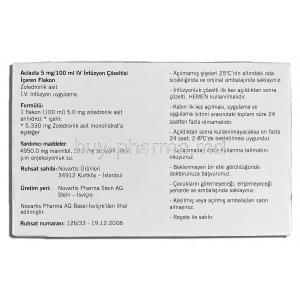Aclasta
- Introduction
- Composition of Aclasta
- How Aclasta Works
- Uses of Aclasta
- Off-Label Uses of Aclasta
- Dosage and Administration
- Side Effects of Aclasta
- VIII. Drug Interactions
- IX. Warnings and Contraindications
- X. Administration Precautions
- XI. Administration to Special Populations
- XII. Overdosage of Aclasta
- XIII. Storage and Handling Precautions
- XIV. Important Considerations Before Receiving Aclasta
Introduction
A. Aclasta Overview Aclasta is an example of innovative pharmaceuticals. It belongs to the bisphosphonate family. It plays a crucial role in managing bone health. It is typically administered once a year through an infusion, it is highly praised for its effectiveness in strengthening bones and reducing the risks associated with fractures caused by osteoporosis. B. Therapeutic Classification As a member of the bisphosphonate group, Aclasta falls under the category of drugs that effectively inhibit bone resorption. This helps stabilize and maintain bone density. C. Importance in Bone Health Management The primary goal of managing bone health is preventing fractures and ensuring a strong skeletal structure. Aclasta plays a role in achieving this objective by providing protection against the gradual deterioration of bone density diseases.
Composition of Aclasta
A. Main ComponentsThe main ingredient in Aclasta is acid, a powerful bisphosphonate that plays a crucial role in fighting against the breakdown of bone tissue caused by osteoclasts.B. Additional IngredientsMannitol Sodium citrate Water, for injection
How Aclasta Works
A. How Aclasta works in bone metabolism by binding to hydroxyapatite crystals in the bone structure, creating a barrier against the breakdown of bones caused by osteoclasts. B. Additionally, Aclasta indirectly helps regulate calcium levels by preventing the release of calcium into the bloodstream when bones are being broken down.
Uses of Aclasta
Aclasta (zoledronic acid) is a bisphosphonate medication that is used to treat osteoporosis in postmenopausal women and in men, to prevent additional fractures in men or women who have recently had a hip fracture, or to treat or prevent osteoporosis in men and women caused by treatment with steroid medicines such as prednisone. Aclasta is also used to treat Paget’s disease of bone 12.
Aclasta has been shown to be effective in the treatment of hypercalcemia (high levels of calcium in the blood) that may occur in patients with some types of cancer. It is also used to treat a cancer called multiple myeloma (tumors formed by the cells of the bone marrow) or certain types of bone metastases (the spread of cancer to the bone) 34.
1: MIMS Philippines 2: Mayo Clinic 3: Mayo Clinic 4: Medical News Today
Off-Label Uses of Aclasta
A. Broadening the Therapeutic ScopeThe potential of Aclasta goes beyond its applications as healthcare professionals are currently investigating its effectiveness in various bone related conditions.B. Ongoing Research and Possible UsesOngoing studies suggest that Aclasta could have an impact on diseases, like osteogenesis imperfecta and other conditions characterized by brittle bones.
References:
Zoledronic acid: A potential therapeutic agent for the treatment of non-skeletal diseases
Dosage and Administration
A. Recommended Dosage The recommended dosage for Aclasta is a single infusion of 5 mg once per year. However, the dosage can be adjusted based on the needs of each patient. B. Method of Administration Healthcare professionals administer Aclasta intravenously, ensuring delivery over a minimum duration of 15 minutes. C. Timing and Frequency of Doses While it is expected to receive an infusion, the exact timing may vary depending on the assessment made by the clinician and the patient's bone mineral density status.

Side Effects of Aclasta
A. Common Side Effects Musculoskeletal Pain: Many recipients may experience aches after the infusion, which is the most common complaint. Flu-like Symptoms: Some patients might have a combination of symptoms that resemble influenza. B. Serious Adverse Reactions Osteonecrosis of the Jaw: Although rare, there have been cases where bisphosphonate therapy has been associated with jaw osteonecrosis. Therefore, careful monitoring is necessary. Renal Impairment; Before each infusion, it is essential to assess function diligently as Aclasta could potentially worsen pre-existing kidney conditions.
VIII. Drug Interactions
A. Concomitant Use with Other Medications
The interaction between Aclasta and other medications can make the intricate dance of pharmacokinetics and pharmacodynamics more complicated. It's essential to be vigilant because certain drugs, those metabolized by the cytochrome P450 system, can either enhance or reduce their effectiveness in unexpected ways. For instance, When nonsteroidal anti-inflammatory drugs (NSAIDs) are used with Aclasta, they may increase the risk of kidney problems. Similarly, combining aminoglycosides with Aclasta could potentially prolong the calcium-lowering effect, leading to a condition called hypocalcemia.
B. Interaction with Calcium Supplements
The complex interaction between Aclasta and calcium supplements needs consideration. To ensure the drug's effectiveness, it is advisable to take calcium supplements at a time other than the Aclasta infusion, avoiding any potential interference with its pharmacological effects.
IX. Warnings and Contraindications
A. Hypocalcemia and Vitamin D Deficiency
Patients who have calcium levels or a deficiency in vitamin D pose a delicate situation. Before receiving the Aclasta infusion, it is essential to address and correct these conditions since Aclasta can potentially decrease serum calcium levels further.
B. Renal Dysfunction
Renal insufficiency continues to be a concern. Aclasta is eliminated through the kidneys. Administering it to patients with impaired renal function could potentially lead to a progressive deterioration of kidney function.
X. Administration Precautions
A. Correcting Electrolyte Imbalances
Electrolyte imbalances can silently indicate problems. Healthcare providers have a responsibility to restore balance before administering Aclasta. The key elements that need correction are calcium, magnesium, and phosphorus.
B. Monitoring Renal Function
Ensuring the accuracy of kidney function is crucial when administering Aclasta safely. It is essential to assess creatinine clearance before and after starting the treatment to prevent any potential harm to the kidneys.
XI. Administration to Special Populations
A. Elderly Patients
Dosage Modifications: Although age itself does not require any changes in dosage, it is the decline in kidney function that may sometimes necessitate adjustments in the dosage. Monitoring Bone Strength: It is crucial to conduct dexa scans to evaluate the effectiveness of the treatment in elderly patients.
B. Pregnant Women and Nursing Mothers
Risks: There is limited evidence regarding the use of Aclasta during pregnancy and breastfeeding, so it is generally not recommended. Treatments: It is advisable to explore safer treatment options to prevent any potential harm or adverse effects on the developing fetus or newborn.
C. Administration to Children
Safety and Effectiveness: Due to the availability of extensive studies on the use of Aclasta in children, it is not recommended for routine use in this age group unless there are specific exceptional clinical situations. Guidelines for Dosage: If there is a need to administer Aclasta to children, it is crucial to adjust the dosage based on their body weight and level of kidney maturity.
XII. Overdosage of Aclasta
A. Symptoms and Signs
Taking too much Aclasta can lead to low levels of calcium, phosphorus, and magnesium in the body. This may cause tingling sensations, muscle spasms, tetany (muscle stiffness), and seizures.

B. Immediate Management and Antidotes
Managing the situation requires administering calcium intravenously, closely monitoring electrolyte levels and kidney function, and utilizing bisphosphonate chelators if needed.
XIII. Storage and Handling Precautions
A. Storage Conditions
Aclasta should be stored at room temperature, away from light, and protected from freezing to ensure its effectiveness as a pharmaceutical.
B. Safe Handling Procedures
Like any medication, it is crucial to maintain the integrity of Aclastas vials until they are ready to be administered. Healthcare professionals should strictly follow techniques during the process.
XIV. Important Considerations Before Receiving Aclasta
A. Comprehensive Medical Assessment
Before starting the Aclasta treatment, it is essential to undergo a medical evaluation considering other existing health conditions, medications being taken simultaneously, and overall well-being.
B. Lifestyle and Dietary Considerations
It is important to advise patients about making lifestyle changes, like quitting smoking and reducing alcohol consumption. Additionally, they should be given recommendations to ensure they have enough calcium and vitamin D to help improve the effectiveness of Aclastas treatment benefits.








